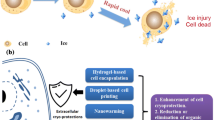Summary
A method is described for the preservation and subsequent recovery of hepatocytes obtained by collagenase perfusion of cynomolgus monkey (Macaca, fascicularis) livers. The fresh cells are suspended in fetal bovine serum containing 10% dimethylsulfoxide and, using a microprocessor-controlled, liquid nitrogen freezing chamber and a specific cooling protocol, processed in such a way that they can be stored in liquid nitrogen for several months and still restored to active culture. When the cryopreserved cells were established in culture they were found to actively synthesize and secrete both albumin and apolipoprotein A-I. That, taken together with morphologic evidence, was viewed as indication that the cells recovered in culture were in fact hepatocytes and not some other cell type from the monkey liver. The availability of this procedure for storing hepatocytes should contribute significantly to the efficient use of nonhuman primates as models with which to study hepatic metabolism.
Similar content being viewed by others
References
Baffet, G.; Clement, B.; Glaise, D., et al. Hydrocortisone modulates the production of extracellular material and albumin in long-term cultures of adult rat hepatocytes with other liver epithelial cells. Biochem. Biophys. Res. Comm. 109:507–512; 1982.
Guguen-Guillouzo, C.; Guillouzo, A. Modulation of functional activities in cultured rat hepatocytes. Mol. Cell Biochem. 53–54:35–56; 1983.
Kreamer, B. L.; Staecker, J. L.; Sawada, N., et al. Use of a lowspeed, iso-density percoll centrifugation method to increase viability of isolated rat hepatocyte preparations. In Vitro Cell. Dev. Biol. 22:201–211; 1986.
Laemmli, U. K. Cleavage of structural proteins during the assembly of the head of bacteriophage T-4. Nature 227:680–685; 1970.
Melchior, G. W.; Willard, S. C.; Brandon, M. T. Apo E levels and distribution in rhesus monkeys consuming an atherogenic diet. Atherosclerosis 58:65–80; 1985.
Oyama, V. I.; Eagle, H. Measurement of cell growth in tissue culture with a phenol reagent. Proc. Soc. Exp. Biol. Med. 91:305; 1956.
Seglen, P. O. Preparation of isolated rat liver cells. In: Prescott, D. M., ed. Methods in cell biology, vol. 13. New York: Academic Press; 1976:29–83.
Ulrich, R. G.; Aspar, D. G.; Cramer, C. T., et al. Morphology, marker enzyme activity, and fluid phase uptake activity in primary culture of hepatocytes from the primate (Macaca Fascicularis). J. Cell Biol. 107(6):Part 3, Abstr. 3102; 1989.
Author information
Authors and Affiliations
Rights and permissions
About this article
Cite this article
Sun, E.L., Aspar, D.G., Ulrich, R.G. et al. Cryopreservation of cynomolgus monkey (Macaca fascicularis) hepatocytes for subsequent culture and protein synthesis studies. In Vitro Cell Dev Biol 26, 147–150 (1990). https://doi.org/10.1007/BF02624105
Received:
Accepted:
Issue Date:
DOI: https://doi.org/10.1007/BF02624105




